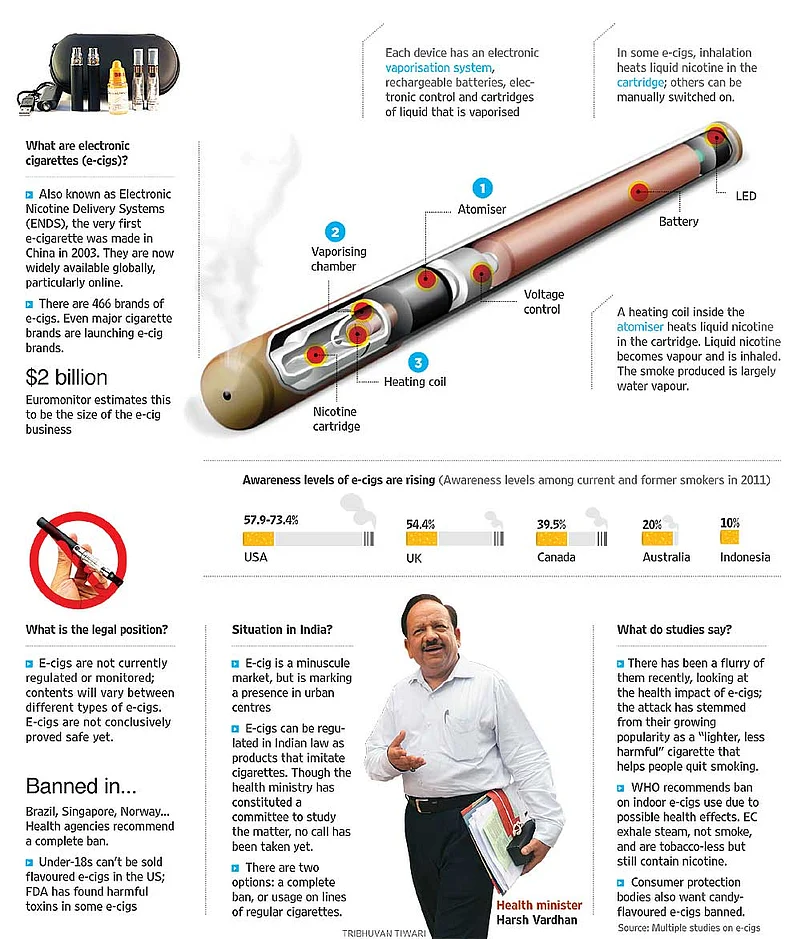When Jaipur businessman Girdhar Bajoria discovered the e-cigarette (e-cig) for the first time—during a visit to his daughters in the US last September—he thought he had at last found a cure to his smoking habit. The mess a lit cigarette creates—ash, smoke, lingering tell-tale odour—all that vanishes overnight from Bajoria’s life. His family was happy, they also proved less expensive—around Rs 2,000 for the device itself, and another Rs 80 for the nicotine refill. “E-cigs don’t have even 10 per cent of the problems regular cigarettes have,” Bajoria would say. With every drag, an e-cig injects a dose of nicotine into the smoker, leaving in its wake not a puff of smoke but a cloud of steam.
Then the problems began for Bajoria. First, he started having trouble finding the right brand of e-cigs in India, ones that didn’t leave a bitter aftertaste. Then he started reading reports about the harmful chemicals in the innocent-looking steam clouds of e-cigs. Now he simultaneously worries about both prospects —losing the relative benefits of smoking e-cigs, and the possibility of new, different health risks emerging.
The Union health ministry has, in fact, set up a panel of experts to examine the need to regulate e-cigs or even ban them completely, since currently they fall in the grey zone of the law on tobacco and its use. Free of tobacco but containing nicotine, the e-cig is neither cigarette nor addiction-free. “The fact that they are here,” says Pradeep S. Mehta, who runs CUTS, a consumer rights organisation, “should not be a cause for much delay in putting up appropriate regulations. Even cable TV came to India before the laws came in—hopefully, the government will act fast in this case.”

The panel constituted by the health ministry, which has met once so far, has now been broken into different expert groups examining the financial, legal, health and technical aspects of e-cigs. “The consensus in their first meeting was—more or less—to ban e-cigs,” says a member of the panel. No date has been set up for their next meeting yet, a government official reveals, adding that the panel is yet to take a firm view.
India was quick to pick on the growing unease with the popularity of e-cigs, on the heels of a who warning on August 26 against using them indoors. “An appropriate government body must restrict e-cigarette advertising, promotion and sponsorship, to ensure that it does not target youth and non-smokers or people who do not currently use nicotine,” the WHO report says. Other international health agencies also cite the possibility of very serious health concerns. The International Union Against Tuberculosis and Lung Disease, for instance, recommends “a comprehensive ban on all advertising, promotion and sponsorship of e-cigs”.
Some studies have found that e-cigs neither lower the health risks of conventional tobacco, nor reduce tobacco consumption. Between users, the buzz is they help quit the worst effects of smoking—cancer included—while satisfying the brain’s urge for nicotine. This, health professionals say, is cause for concern. “More than cessation, e-cigs have been found to be a way for the youth to smoke more—a kind of gateway (cigarette) drug,” says Dr Monica Arora, director, health promotion and tobacco control, Public Health Foundation of India.
Opinion, though, remains divided. Tobacco was the cause of 100 million deaths in the previous century, which has some experts favouring a calibrated approach to regulating e-cigs. For instance, a recent report cited Ann McNeill, professor at the National Addiction Centre, King’s College, London, as saying that e-cigs are new and their long-term health impact is far from known, “but what we do know is that they are much safer than cigarettes, which kill over six million people a year worldwide.”
In India too tobacco consumption and cancer are intricately and directly linked. Says Dr B.R. Das, president, research and innovation, srl Ltd, “Among the five most common cancers in India, tobacco-related ones form the largest chunk of the disease burden.” Many smokers of conventional cigarettes, he explains, would find e-cigs a great way to remove around 4,000 harmful chemicals from their systems, not to mention cutting out the harmful second-hand smoke, tar and carbon monoxide. “There’s need for more robust research to make a final medical and clinical comment on e-cigs.”
For now, the consensus seems to be that smoking kills, whether you inhale it as light vapour or as thick smoke.


























